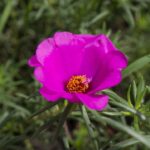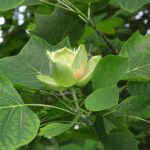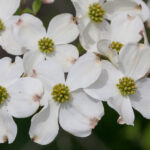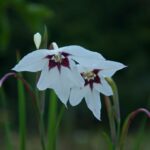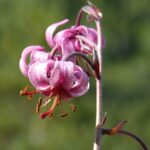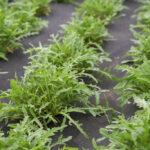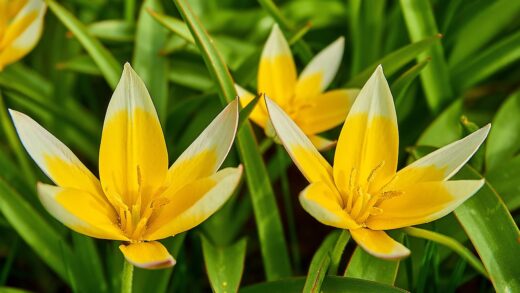The pruning and cutting back of the Turk’s cap lily

The topic of pruning and cutting back Turk’s cap lilies is a straightforward one, as these plants have minimal requirements in this regard, a characteristic that adds to their appeal as a low-maintenance garden perennial. Unlike many shrubs or herbaceous perennials that require regular trimming to maintain their shape or encourage reblooming, the Turk’s cap lily follows a simple, natural life cycle that requires very little interference from the gardener’s shears. The primary “pruning” activities are limited to deadheading the spent flowers and cutting back the entire stalk once it has fully died back at the end of the season. Understanding the correct timing and purpose of these two simple tasks is all that is needed to properly manage the plant’s structure throughout the year.
The main structure of the Turk’s cap lily is a single, unbranched stem that emerges from the bulb in the spring, grows to its full height, produces a cluster of flowers at its apex, and then begins to senesce after the flowering period is over. There is no benefit to be gained from pinching back the new growth in the spring, as one might do with some other perennials to encourage bushier growth. Doing so would only remove the terminal bud where the flowers are destined to form, effectively eliminating the floral display for that year. The plant’s natural, elegant, and upright form should be allowed to develop without interference.
The foliage of the Turk’s cap lily consists of whorls of leaves arranged along this central stem. This foliage is critically important for the health of the plant, as it is the engine of photosynthesis that creates the energy stored in the bulb for the following year’s growth. For this reason, it is absolutely essential that the leaves are not cut back while they are still green. The only time any part of the green plant should be removed is if it shows signs of disease, in which case the affected portion should be promptly cut off and destroyed to prevent the problem from spreading.
Therefore, the practice of pruning for this species is not about shaping the plant or stimulating new growth, but rather about tidying the plant after its functional life cycle for the season is complete and directing its energy in the most efficient way possible. It is a process that works in harmony with the plant’s natural rhythms, rather than trying to alter them. This minimalistic approach makes the Turk’s cap lily an excellent choice for gardeners who appreciate naturalistic planting styles and prefer plants that do not demand a great deal of fussy maintenance.
Deadheading after flowering
Deadheading is the practice of removing the flowers from a plant once they have faded. For the Turk’s cap lily, this is the one pruning-related task that should be carried out during the active growing season. The primary purpose of deadheading is to prevent the plant from expending its energy on producing seeds. Once a lily flower has been pollinated, it will begin to form a seed pod, a process that requires a significant amount of the plant’s energy resources. By removing the faded flower, the gardener redirects that energy downward, into the bulb, where it can be stored for the next year’s flower production.
More articles on this topic
The process of deadheading is simple. As each individual flower on the stalk begins to wilt and drop its petals, it can be snapped off by hand at the small stem (the pedicel) that connects it to the main flower stalk. Alternatively, a pair of small, sharp pruners can be used. It is important to be careful not to damage any of the remaining flowers or buds on the stalk. This should be done on an ongoing basis as the flowers fade sequentially over a period of several weeks.
This simple act can have a noticeable impact on the long-term vigor of the plant and the quality of its future floral displays. A bulb that has been able to store more energy will be larger and healthier, and it will be capable of producing a taller stem with a greater number of flowers in the subsequent season. While allowing a few seed pods to develop will not seriously harm a well-established plant, consistently preventing seed formation is a best practice for maximizing the ornamental value of the lily.
The only exception to this rule is if the gardener wishes to collect seed for propagation. In this case, the most vigorous-looking flowers should be left on the plant to allow the seed pods to develop and ripen fully. The pods are ready for harvest when they have turned brown and dry and have begun to split open at the top. For all other purposes, however, prompt deadheading is recommended as a beneficial part of the plant’s post-flowering care regimen.
Cutting back at the end of the season
The most significant cutting back of the Turk’s cap lily occurs at the end of its growing season, in the autumn. After the plant has finished flowering, the stem and its whorls of leaves must be left intact for as long as they remain green. During this period, which can last for several weeks or even a couple of months, the foliage is actively photosynthesizing and transferring energy down to the bulb. This is a critical time for the plant to recharge and build up the reserves it needs to survive the winter and produce a new stem in the spring.
More articles on this topic
The signal to cut the plant back is when the stem and leaves have turned completely yellow or brown and have started to wither. This indicates that the process of senescence is complete and all the available energy has been drawn back into the bulb. At this point, the stalk no longer serves any purpose for the plant. Cutting it back before it has fully died back will short-circuit this vital energy storage process and will result in a weaker plant and a poorer floral display in the following year. Patience is key during this phase.
Once the stalk is fully brown and dry, it can be cut down to just a few centimeters above the soil line using a sharp pair of pruners or shears. This is primarily done for reasons of garden hygiene and aesthetics. Removing the dead stalk cleans up the appearance of the garden bed for the winter. More importantly, it removes any potential overwintering sites for pests or fungal spores that might be lingering on the dead plant material, which helps to promote a healthier start for the plant in the spring.
The cut stems and foliage should be removed from the garden and can be added to the compost pile, provided they did not show any signs of disease during the growing season. If there was any evidence of a fungal issue like botrytis, it is safer to dispose of the debris in the trash rather than composting it, to avoid reintroducing the pathogen into the garden environment. This final cutback is the last act of care for the lily before it enters its long winter dormancy.





